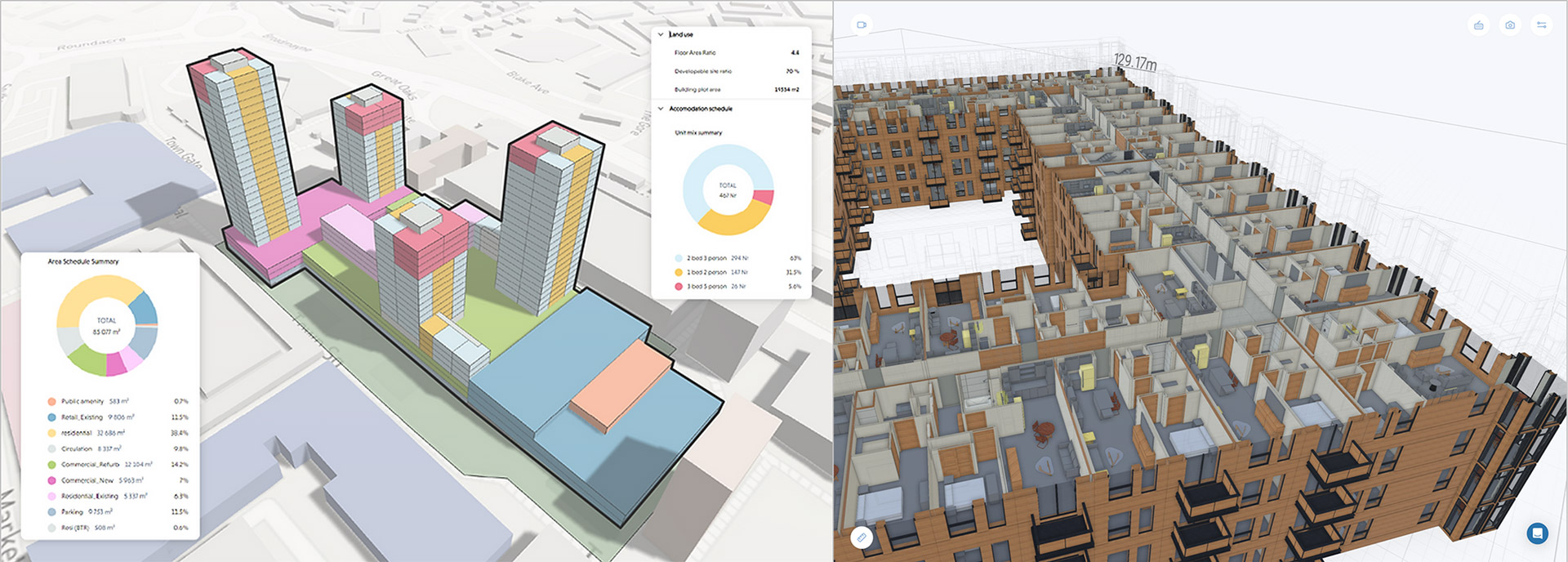The adoption of modular principles is transforming the architectural field, demanding architects to adapt their roles to harness the full potential of modular, generative design. Thought leaders like Bjarke Ingels, Neri Oxman, and Patrik Schumacher, as well as technological advancements in parametric design and digital fabrication, provide valuable insights and software for architects to navigate this transformation, writes Richard Harpham
One of the most significant shifts in the architectural landscape in recent times is the increasing adoption of modular principles in architectural design and construction. The confluence of technological advancements, environmental considerations, and changing societal needs has generated new energy around modular design.
Modularity is more efficient, more cost effective, and is inherently adaptable. But it requires architects to change how they approach design. To effectively integrate modular principles into their designs, architects must adapt their practice to leverage the knowledge gained from previous successful projects. In this article, we will explore how architects’ roles are evolving to facilitate the reuse of knowledge from past projects and how thought leaders in architecture and technology are guiding this transformation.
Deep-rooted practices
Before we go too much further, we need to examine why it’s been so hard for architects and contractors to learn from modular trailblazing done by more efficient industries, like manufacturing, aviation, and automotive. There are two primary reasons. First, contractual frameworks require architects and engineers to spend exasperating time documenting designs, rather than exploring how to better make and construct them. Couple that with design software that still emulates the drawing board, and we have an incredibly inflexible core ‘operating system.’
Find this article plus many more in the September / October 2023 Edition of AEC Magazine
👉 Subscribe FREE here 👈
These legacy processes hinder the building production industry’s ability to transform. Consumers, meanwhile, have become accustomed to mass customisation, rapid change, and fast results. It seems that our industry is completely out of step with the rest of the world.
20 years ago, in their book, ‘Re-fabricating Architecture,’ Kieran and Timberlake explored the potential of prefabrication in architecture and advocated for a fundamental shift in design and construction processes. They asserted that an industry-wide failure to look at process has led entire generations of architects to overlook how to transfer technologies and processes from other industries. They called for a re-evaluation of our traditional approaches to architecture. They noted that figuring out all of the physical joints on the site during construction takes the most time, leads to the most problems, and is the most expensive option. Instead, the designer should ‘chunk’ buildings up. By prefabricating these chunks, builders have fewer physical joints to figure out in the field.
While re-fabricating architecture focused on the physical world, it can also be applied to the virtual world.
Innovation through modular principles: design and technology
Emerging thought leaders in architecture and technology have taken Kieran and Timberlake’s ideas further, inspiring new ways of thinking, driving innovation, and encouraging the integration of modular principles.
Bjarke Ingels, an influential Danish architect, is known for his innovative approach to design. His architectural firm, Bjarke Ingels Group (BIG), is renowned for merging sustainability, functionality, and aesthetics. Ingels’s work often challenges traditional norms while embracing technological advancements. He envisions designs that can be broken down into adaptable modules, facilitating efficient construction and versatility.
Neri Oxman is a trailblazer at the intersection of architecture, design, and technology. In her work, Oxman explores biomimicry and digital fabrication. Her intricate and adaptable structures blur the boundaries between art and science. Likewise, scripting and digital fabrication tools are starting to encourage architects to create intricate forms and structures that can be inherently modular. In fact, since the late 1990s, the availability of Grasshopper and Dynamo scripting has revolutionised elements of architectural design and construction.
Patrik Schumacher and other leaders in this field advocate for the integration of these tools to achieve modular flexibility and efficiency in a style known as ‘Parametricism’. But architectural roles and processes are slow to leverage this concept, probably because software providers have yet to provide the easy-touse software that allows every designer in the practice to benefit from generative design methods, not just that specialist team of scripting ‘coders’ with powerful computers.
Five ways modular will change architectural practice
The good news is that architects are re-examining their roles to effectively integrate computed modular principles into their designs. A review of recent published ideas and proposals revealed five interesting assertions being tested:
- Knowledge curation and analysis: Architects must establish a digital repository of knowledge from previous projects. This repository should encompass models and data from previous successful modular designs, including structural systems, materials, and construction methodologies. By analysing the performance of modular components in various contexts, architects can make informed decisions for new projects.
- Design frameworks and standardization: Architects must evolve from designing standalone structures to developing adaptable design frameworks. These frameworks consist of standardized modular elements that can be combined in different ways for each new project or proposal. Architects create these frameworks by extracting designs from successful past projects and incorporating them into a modular toolkit.
- Innovative adaptation: In manufacturing, mass customisation is possible due to highly adaptable materials and components, without taxing supply chain and fabrication resources. Similarly, architects must adapt existing modular components to address unique project requirements while ensuring compatibility and efficiency. This approach promotes innovation within the boundaries of established modular frameworks.
- Parametric design and digital fabrication proficiency: Architects are evolving into tech-savvy professionals who can generate complex modular forms and optimise them for fabrication and assembly. They need a new generation of tools to integrate parametric design and digital fabrication into their practice. Now software providers must respond with solutions that make algorithmic and modular generation of designs as easy as lines, arcs and circles.
- Design for constructability: Thought leaders emphasise early interdisciplinary collaboration, and architects must once again have the ‘Master Builder’ skills once typical for an architect. Architects must effectively convey their modular design to prefabricators, engineers, and contractors. This ‘Design for Constructability’ principle ensures that modular components seamlessly integrate into the offsite manufacturing and onsite construction processes.
So why is now the right time for step change in architectural means and methods? Technologies that automate the complex process of reusing model and project data for new projects are coming into the market. With them, designers can rely on automation to rapidly complete time-consuming tasks like shuffling modules and components into optimum layouts, drawing door schedules, and churning out construction documents.
Only then can those designers focus more time on the aesthetic and qualitative elements of building design. Document creation tasks can soon be a thing of the past. They are being replaced by procedural and AI solutions that capture and reuse previous design knowledge under the guidance of a new generation of true architect designer professionals.
Software – ushering in a new era of architectural innovation
If software solutions can curate knowledge and help develop adaptable design frameworks, they will foster innovative adaptation in both process and design outcomes.
Recently, I have worked with several innovators pushing in this direction. Altaf Ganihar, the founder and CEO of Snaptrude, has spent six years developing a true cloud-based architectural design solution that can integrate information from all the current BIM solutions in the market, removing the need for tools like SketchUp, ensuring early design ideas can quickly move into Revit BIM models. While his team has made great strides this year, one solution cannot solve the myriad needs the architects require.
Another solution aims to improve design workflows by augmenting what Revit does well with solving productivity issues it has not improved in design practices. Recently, I had the pleasure of getting reacquainted with Marty Rozmanith, a former colleague from Revit Technologies and the original product manager for Revit.
We each went on from Revit to work in Autodesk, Dassault Systèmes, and Katerra, among others. Now, we have brought our perspectives together to birth a new solution called Skema. Skema executes the early tasks of delivering design proposals with dramatic efficiency. Skema aims to digitally leverage model and specification data from a firm’s previous projects to accelerate early design, delivering a reliable LOD350 BIM model in days rather than weeks. These proposals are then easily adaptable, and responsive to changes during the typically expensive process of refining final designs to the client’s needs. Skema’s cutting-edge technology packages up the embedded knowledge in design responses that architects have already created in previous projects.

As recently highlighted at AEC Magazine’s NXT BLD and NXT DEV events in London, and within the Design Futures Council, architects are making it clear that they need federated solutions that integrate with each other and respond to the way they want to deliver designs.
Both Snaptrude and Skema can work separately, in combination, and with solutions like Revit to solve and extend productivity in architectural workflows, while still working well with the huge investments in software and training our industry has made getting this far.
These solutions are built to fit into the architect’s world, not the other way round. This seems like good news to me.
Richard Harpham recently cofounded Blue Ocean to bring Skema to market.
Main image: Dortheavej Residence by Bjarke Ingels Group. Image courtesy of Martin Auchenberg






